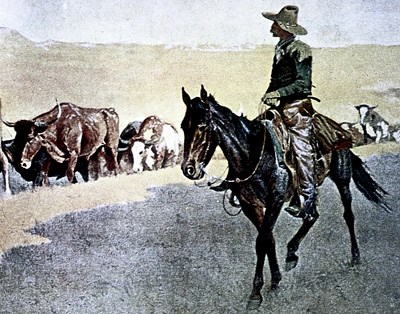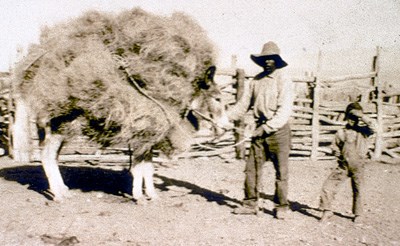|
The history and culture of Big Bend is intertwined with the history and culture of Mexico. This land was part of Mexico until the treaty of Guadalupe Hidalgo was signed in 1848. The earliest settlers were Mexicans who established residence here in the early 1800s. Yet the traditional history of the Big Bend overlooks these settlers of Mexican origins; it focuses mainly on Anglo-American settlement that took place mostly in the late 1800s. Many details of the history of Mexican settlement here have been lost with time. Most people of Mexican origins in Big Bend had few opportunities for formal education; therefore, few historical records were kept. Available historical records show that by the time that Anglo-American settlers moved into this region in the late 1800s, Mexican and Mexican American families were already living here. 
Mexican “vaqueros,” Spanish for cowboys, were renowned for their horsemanship and knowledge of cattle and began raising cattle along the Rio Grande in the 1830s. The Mexican stockmen were familiar with the dry climate of the Chihuahuan Desert, and they raised a rugged, thin-blooded variety of longhorn that was well adapted to desert conditions. Attracted to the grazing lands and abundant spring water of the Big Bend, Mexican vaqueros drove their herds north across the Rio Grande where some established successful ranching operations. Cresencio Sanchez and Liberato Gamboa of San Vicente, Texas, became permanent employees of Fred Rice, who ranched at Grapevine Hills. Fred Rice often noted what outstanding horsemen these Mexican American cowboys were. Viviano Castillo, known for his skill in masonry, built a large water tank at Chilicotal spring for John Rice. Simon Celaya, originally from San Luis, Potosi, Mexico, worked for many years as a ranch hand for Coleman Babb at the K-Bar ranch. 
Other Big Bend residents of Mexican descent chose not to work for local ranchers. They established homesteads and survived by subsistence farming and raising sheep and goats. These settlers developed ingenious methods for farming in the desert. Armed with an intimate knowledge of which plants could succeed in the desert climate, those who homesteaded near the Rio Grande or desert springs would use these water sources to irrigate their crops. Others, located far from water, farmed seasonally by locating their farms near washes and diverting water from flash floods during the rainy season. Many supplemented their incomes by harvesting candellia, a desert plant from which they would render a fine wax, by baling hay and selling it to the local military and mining camps, by cutting and hauling wood to nearby settlements, or by trapping and trading furs at local trading posts. By 1898, mining activities in Mexico’s Sierra del Carmen led to the settlement of Boquillas, Mexico. A group of Texas investors worked with the Puerto Rico Mining Company in Mexico to move large quantities of lead, zinc and silver ore to the railroad in Marathon, Texas. Utilizing Mexican and Mexican American labor, they constructed a cable tram across the Rio Grande that spanned six miles of desert terrain. The tramway was successful until the mine closed shortly after World War I. After some of the mines in the Boquillas area closed in 1919, farming along the river floodplain became the major activity of the area. Martin Solis and his son Benito were among the most prominent farmers in the area. Farming along the Rio Grande was also an important way of life in the Castolon area. Mexican families began moving to the area in the mid-1800s, and in the early 1900’s, Martin Solis was among the first to farm there. When other farming settlements appeared near Castolon, Cipriano Hernandez opened a small store where he sold supplies to his neighbors. Today, the store building is known as the Alvino House, and is the oldest known adobe structure standing in the park. Stockmen, homesteaders, farmers, wax makers, trappers, goatherds, miners and freighters, the settlers of the Big Bend whose ancestors came from Mexico transformed their dedicated labor into a way of life that sustained them through the generations. The original settlers of the Big Bend region, although almost forgotten by history, lived and died on this land. They maintained their unique culture despite changes to the region’s government, economy, and language. The culture of the settlers of Mexican origin still plays a major role in the Big Bend region. Today we find the descendants of the original settlers of the Big Bend taking their rightful place in society. Heirs to a culture that emphasizes the importance of family, hard work, and the spirit of survival, they continue to exemplify the values that are their cultural legacy. |
Last updated: March 8, 2022
